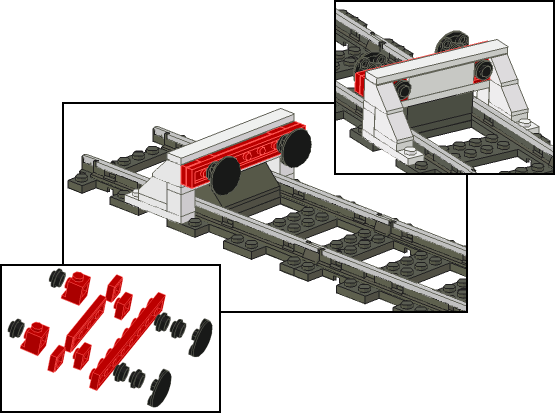| |
In lugnet.trains, Didier Enjary wrote:
| |
With the help of Tim, I’ve translated Erik Amzallag
article about bumpers.
The english version
It’s a brief review of what has been done on the subject.
|
There are some nice ideas there - I particularly like the chequered stop marker.
Here’s my version of a very old British wooden type:

The dark grey plate and slope aren’t really part of the design, but they do give
it a lot more stopping power.
It’s in use in this picture:

I’d first seen Huw Millington using the boat studs (listed on LDRAW as a ‘dish’
for some reason) as buffers. Here’s one of his shock-absorbing designs:

The most impressive way I found of stopping a train was simply a 2x2 brick on
the track. I once ran a small shunting engine (0-4-0, based on single motor) at
one at full speed during a display. Mark Palmer dived to catch it, but the
brick stopped it dead.
Of course, if you’ve got some of this
track you don’t need buffers...
Jason R
|
|
| |
In lugnet.trains, Jason J Railton wrote:
| |
In lugnet.trains, Didier Enjary wrote:
| |
With the help of Tim, I’ve translated Erik Amzallag
article about bumpers.
The english version
It’s a brief review of what has been done on the subject.
|
There are some nice ideas there - I particularly like the chequered stop
marker.
Here’s my version of a very old British wooden type:

The dark grey plate and slope aren’t really part of the design, but they do
give it a lot more stopping power.
|
Nice ! Thanks for sharing.
| |
It’s in use in this picture:

I’d first seen Huw Millington using the boat studs (listed on LDRAW as a
‘dish’ for some reason)
|
I do prefer form-based names for parts rather than use-based names. Inverted 2x2
dishes are boat studs only when used .... as a boat stud
QED
| |
Here’s one of his shock-absorbing
designs:

|
If Huw reads these lines, it will be nice of him to share with us some details.
The shock absorbing mechanism is not clear to me from the picture.
| |
The most impressive way I found of stopping a train was simply a 2x2 brick on
the track. I once ran a small shunting engine (0-4-0, based on single motor)
at one at full speed during a display.
|
Worth noticing - I’m afraid it hurts too much the parts in contact.
| |
Mark Palmer dived to catch it,
|
I hope he’s ok and that nothing stopped him dead :-)
| |
but
the brick stopped it dead.
Of course, if you’ve got some of this track you don’t need buffers...
|
Only true for the functional part of the use - not for the decorative use of
buffers stops. Very interesting link for modders.
I have some translation work now from english into french :-)
|
|
| |
In lugnet.trains, Didier Enjary wrote:
| |
I do prefer form-based names for parts rather than use-based names. Inverted
2x2 dishes are boat studs only when used .... as a boat stud
|
Yes, but that’s what LEGO use them for 90% of the time, and what everyone calls
them. It took me ages to find them in the parts list. I had to use Google to
find the part number, then search for that in MLCAD.
Not funny.
| |
| |
Here’s one of his shock-absorbing
designs:

|
If Huw reads these lines, it will be nice of him to share with us some
details. The shock absorbing mechanism is not clear to me from the picture.
|
The ‘BOAT STUDS’ are on the end of axles, which go through technic 1x1 bricks
and are linked by a bar across the back. I seem to remember there’s an elastic
band to hold them in place and absorb any impact.
| |
| |
Mark Palmer dived to catch it,
|
I hope he’s ok and that nothing stopped him dead :-)
|
Well, it was one of those feeble school-football goalkeeper dives, where you
actually just take a big step to the side. I’m not sure he’d have made it
anyway...
| |
| |
Of course, if you’ve got some of this track you don’t need buffers...
|
Only true for the functional part of the use - not for the decorative use of
buffers stops. Very interesting link for modders.
I have some translation work now from english into french :-)
|
Ooh, I always find that so much more difficult... ;-)
Jason R
|
|
|